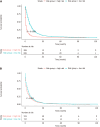Risk stratification in gastric cancer lung metastasis: Utilizing an overall survival nomogram and comparing it with previous staging
- PMID: 38463363
- PMCID: PMC10921188
- DOI: 10.4240/wjgs.v16.i2.357
Risk stratification in gastric cancer lung metastasis: Utilizing an overall survival nomogram and comparing it with previous staging
Abstract
Background: Gastric cancer (GC) is prevalent and aggressive, especially when patients have distant lung metastases, which often places patients into advanced stages. By identifying prognostic variables for lung metastasis in GC patients, it may be possible to construct a good prediction model for both overall survival (OS) and the cumulative incidence prediction (CIP) plot of the tumour.
Aim: To investigate the predictors of GC with lung metastasis (GCLM) to produce nomograms for OS and generate CIP by using cancer-specific survival (CSS) data.
Methods: Data from January 2000 to December 2020 involving 1652 patients with GCLM were obtained from the Surveillance, epidemiology, and end results program database. The major observational endpoint was OS; hence, patients were separated into training and validation groups. Correlation analysis determined various connections. Univariate and multivariate Cox analyses validated the independent predictive factors. Nomogram distinction and calibration were performed with the time-dependent area under the curve (AUC) and calibration curves. To evaluate the accuracy and clinical usefulness of the nomograms, decision curve analysis (DCA) was performed. The clinical utility of the novel prognostic model was compared to that of the 7th edition of the American Joint Committee on Cancer (AJCC) staging system by utilizing Net Reclassification Improvement (NRI) and Integrated Discrimination Improvement (IDI). Finally, the OS prognostic model and Cox-AJCC risk stratification model modified for the AJCC system were compared.
Results: For the purpose of creating the OS nomogram, a CIP plot based on CSS was generated. Cox multivariate regression analysis identified eleven significant prognostic factors (P < 0.05) related to liver metastasis, bone metastasis, primary site, surgery, regional surgery, treatment sequence, chemotherapy, radiotherapy, positive lymph node count, N staging, and time from diagnosis to treatment. It was clear from the DCA (net benefit > 0), time-dependent ROC curve (training/validation set AUC > 0.7), and calibration curve (reliability slope closer to 45 degrees) results that the OS nomogram demonstrated a high level of predictive efficiency. The OS prediction model (New Model AUC = 0.83) also performed much better than the old Cox-AJCC model (AUC difference between the new model and the old model greater than 0) in terms of risk stratification (P < 0.0001) and verification using the IDI and NRI.
Conclusion: The OS nomogram for GCLM successfully predicts 1- and 3-year OS. Moreover, this approach can help to appropriately classify patients into high-risk and low-risk groups, thereby guiding treatment.
Keywords: Epidemiology; Gastric cancer; Lung metastasis; Nomograms; Overall survival; Prognosis; Surveillance; Surveillance epidemiology and end results program database.
©The Author(s) 2024. Published by Baishideng Publishing Group Inc. All rights reserved.
Conflict of interest statement
Conflict-of-interest statement: All the authors report no relevant conflicts of interest for this article.
Figures










Similar articles
-
Development and validation of two nomograms for predicting overall survival and cancer-specific survival in gastric cancer patients with liver metastases: A retrospective cohort study from SEER database.Transl Oncol. 2022 Oct;24:101480. doi: 10.1016/j.tranon.2022.101480. Epub 2022 Jul 19. Transl Oncol. 2022. PMID: 35868142 Free PMC article.
-
Development and validation of two nomograms for predicting overall survival and Cancer-specific survival in prostate cancer patients with bone metastases: a population-based study.BMC Urol. 2023 Dec 5;23(1):200. doi: 10.1186/s12894-023-01372-w. BMC Urol. 2023. PMID: 38049755 Free PMC article.
-
Prognostic nomograms for breast cancer with lung metastasis: a SEER-based population study.BMC Womens Health. 2024 Jan 3;24(1):16. doi: 10.1186/s12905-023-02848-5. BMC Womens Health. 2024. PMID: 38172874 Free PMC article.
-
Association between modified weight loss grading system and overall survival in adults with lung cancer: A retrospective cohort study.JPEN J Parenter Enteral Nutr. 2025 May 27. doi: 10.1002/jpen.2775. Online ahead of print. JPEN J Parenter Enteral Nutr. 2025. PMID: 40426331 Review.
-
Suggestions for designing studies investigating diagnostic accuracy of biomarkers.Ann Transl Med. 2019 Dec;7(23):788. doi: 10.21037/atm.2019.11.133. Ann Transl Med. 2019. PMID: 32042804 Free PMC article. Review.
Cited by
-
Application and progress of nomograms in gastric cancer.Front Med (Lausanne). 2025 Jan 29;12:1510742. doi: 10.3389/fmed.2025.1510742. eCollection 2025. Front Med (Lausanne). 2025. PMID: 39944483 Free PMC article. Review.
References
-
- Gu J, Chu X, Huo Y, Liu C, Chen Q, Hu S, Pei Y, Ding P, Pang S, Wang M. Gastric cancer-derived exosomes facilitate pulmonary metastasis by activating ERK-mediated immunosuppressive macrophage polarization. J Cell Biochem. 2023;124:557–572. - PubMed
LinkOut - more resources
Full Text Sources
Research Materials
Miscellaneous

